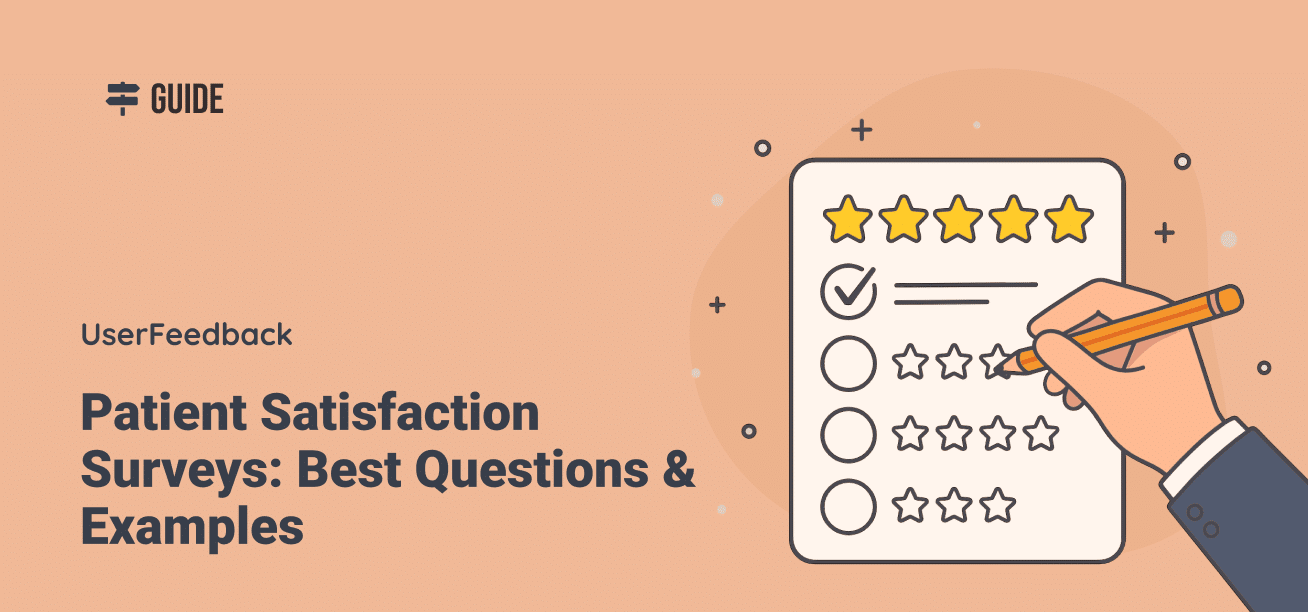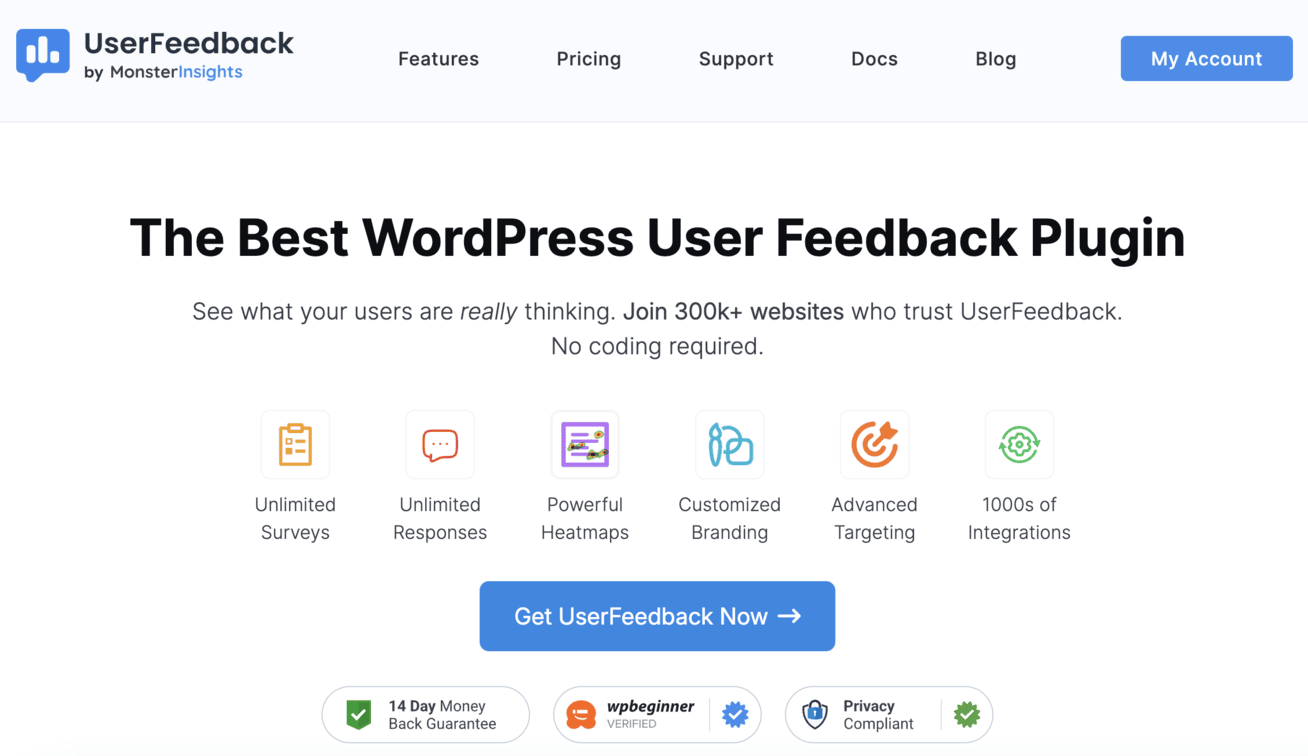Your patients walk out the door after their appointment, but do you know if they’re happy with their care? Without feedback, you’re flying blind when it comes to patient experience. That’s where patient satisfaction surveys come in.
The truth is, most healthcare providers recognize the importance of collecting patient feedback. Still, many struggle with determining the right questions to ask and how to effectively act on the results.
So, in this guide, I’ll share everything you need to know about creating patient satisfaction surveys that actually drive results. You’ll get 40+ proven survey questions, step-by-step instructions for building your own surveys, and practical tips to boost response rates.
Table of Contents
- What Are Patient Satisfaction Surveys?
- Why Patient Satisfaction Surveys Matter
- Easiest Way to Create Patient Satisfaction Surveys
- 40+ Patient Satisfaction Survey Examples
- How to Create a Patient Satisfaction Survey (Step-by-Step)
- FAQs
What Are Patient Satisfaction Surveys?
A patient satisfaction survey is a tool that collects feedback about patients’ healthcare experiences. These surveys measure how well your services meet patient expectations across different touchpoints – from scheduling appointments to discharge instructions.
Patient satisfaction surveys typically ask about:
- Quality of care received
- Communication with healthcare providers
- Wait times and scheduling
- Staff professionalism
- Facility cleanliness
- Overall experience
The feedback helps you identify what’s working well and where you need to improve. But here’s what most people don’t realize: patient satisfaction surveys aren’t just nice-to-have feedback tools. They’re becoming essential for healthcare operations.
Why Patient Satisfaction Surveys Matter
I can’t stress this enough – patient satisfaction directly impacts your healthcare organization’s success. Let me break down why these surveys are so important:
Better Health Outcomes
Research shows that satisfied patients have better health outcomes. A 2010 study found that patient satisfaction was positively correlated with 13 of 14 measures of success for heart attack treatment.
For every 25% increase in patient satisfaction scores, there was an equivalent 25% improvement in predicted survival rates.
Patient Retention
Happy patients stay with your practice. Research shows that satisfied patients are three times more likely to remain with their provider than those with poor relationships. They also follow treatment plans more consistently.
Reputation Management
In one study, more than 80% of patients who used a feedback system said they would likely use it again, and nearly 90% would recommend it to others. Positive patient experiences lead to referrals and better online reviews.
Staff Performance Insights
Patient surveys help you evaluate how your team performs from the patient’s perspective. This feedback guides targeted training and professional development programs.
Easiest Way to Create Patient Satisfaction Surveys
Now that you know exactly how powerful patient satisfaction surveys are, I want to introduce you to the best tool if you’re running a WordPress website: UserFeedback.
UserFeedback is the best feedback plugin that makes collecting meaningful patient insights incredibly simple.
What makes UserFeedback perfect for patient satisfaction surveys specifically:
- Pre-built templates that follow industry standards with professionally designed rating scales
- Conditional logic that creates personalized follow-up questions based on how patients respond – perfect for diving deeper into specific care concerns
- Smart targeting that shows your survey to specific patient segments or on particular pages (like post-appointment confirmation pages)
- Detailed reporting dashboard that calculates important metrics like Net Promoter Scores automatically for your practice
- Comment boxes that capture valuable qualitative feedback alongside numerical ratings – essential for understanding patient experiences
- Custom branding options to make surveys match your practice’s professional look and feel
- AI feedback analysis features that allow you to summarize and analyze patient survey results with a single click
The Pro version takes your patient satisfaction surveys to another level with scheduled surveys (perfect for tracking patient satisfaction trends over time) and advanced email notification settings that alert you immediately when dissatisfied patients need attention – crucial for healthcare reputation management.
Plus, UserFeedback integrates seamlessly with MonsterInsights, meaning you can connect your patient satisfaction data directly with your Google Analytics to see exactly how patient satisfaction impacts key practice metrics like appointment bookings, patient retention, and referral rates.
For healthcare organizations serious about improving patient experience, UserFeedback removes all the technical barriers so you can focus on what matters most – providing excellent patient care.
Get started with UserFeedback today!
40+ Patient Satisfaction Survey Examples
Now let’s get into the specific questions and examples you should ask. I’ve organized these into categories based on different aspects of the patient experience:
Questions About Appointment Scheduling
The scheduling process is often a patient’s first interaction with your practice. Make sure it’s a positive one.
- How easy was it to schedule your appointment?
- Were you able to schedule your appointment at a convenient time?
- How satisfied are you with the time between booking and your actual visit?
- How well did we communicate about any delays or rescheduling?
- Was our online scheduling system easy to use?
Questions About Wait Times
Long wait times are one of the biggest complaints in healthcare. Track these metrics carefully.
- How long did you wait past your scheduled appointment time to be seen?
- How satisfied are you with your wait time in the waiting room?
- Were you informed about delays during your visit?
- How reasonable was the wait time for your test results?
- Did the wait time affect your overall experience?
Questions About Staff Interaction
Your staff sets the tone for the entire patient experience. These questions help you evaluate their performance.
- How would you rate the professionalism of our front desk staff?
- Were you treated with respect and courtesy by all staff members?
- How comfortable did our staff make you feel during your visit?
- Did staff members clearly explain procedures and next steps?
- How helpful was our staff in addressing your concerns?
Questions About Provider Communication
Communication with healthcare providers is crucial for patient satisfaction and health outcomes.
- How well did your provider listen to you?
- Did your provider spend enough time with you?
- How clearly did your provider explain your condition?
- Did you feel comfortable asking questions?
- How well did your provider involve you in treatment decisions?
Questions About Quality of Care
These questions get to the heart of why patients visit your practice.
- How satisfied are you with the overall quality of care you received?
- Did you feel your provider was thorough and attentive?
- How confident are you in the medical advice you received?
- Were your concerns taken seriously and addressed appropriately?
- Did you feel your treatment plan was appropriate for your condition?
Questions About Facility and Environment
The physical environment affects patient comfort and perception of care quality.
- How would you rate the cleanliness of our facility?
- How comfortable was the waiting area?
- Did our facility feel safe and well-maintained?
- How would you rate the privacy during your visit?
- Were directions and signage clear throughout the facility?
Questions About Billing and Administrative Experience
Billing issues can significantly impact patient satisfaction, even when clinical care is excellent.
- How easy was it to understand your bill?
- Were your insurance and payment options clearly explained?
- How satisfied are you with our billing and administrative support?
- How quickly were billing questions resolved?
- Did you receive clear information about costs upfront?
Questions About Follow-Up Care
Post-visit communication is often overlooked but critical for patient satisfaction.
- How clear were your discharge instructions?
- Did you receive appropriate follow-up communication?
- How easy was it to contact us with questions after your visit?
- Were you satisfied with the coordination between different providers?
- Did you feel prepared to manage your care at home?
Overall Satisfaction Questions
These questions measure the patient’s overall impression and likelihood of returning.
- How would you rate your overall experience with our practice?
- How likely are you to recommend us to family or friends?
- Would you choose to return to our practice for future healthcare needs?
- Did your experience meet, exceed, or fall short of your expectations?
Open-Ended Questions
Include at least one open-ended question to capture insights you might not have considered.
- What did you appreciate most about your visit?
- What could we improve to provide a better experience?
- Is there anything else you’d like us to know about your experience?
How to Create a Patient Satisfaction Survey (Step-by-Step)

Creating an effective patient satisfaction survey doesn’t have to be complicated. Follow these steps to build surveys that get results:
Step 1: Define Your Goals
Start by identifying what you want to learn. Are you looking to improve wait times? Enhance staff communication? Upgrade your facilities? Having clear goals helps you choose the right questions and measure success.
Step 2: Choose Your Survey Method
You have several options for distributing surveys:
- Digital Surveys: Email, text message, or online forms. These are cost-effective and provide real-time results.
- Paper Surveys: Traditional but still effective, especially for older patients. However, digital patient satisfaction surveys are more effective than paper surveys due to their efficiency and advanced features.
- Phone Surveys: Allow for follow-up questions but require more staff time.
- In-Person Surveys: Can be done via tablets in waiting rooms or at checkout.
Step 3: Select Your Questions
Choose 5-10 questions that align with your goals. Don’t make surveys too long – patients are more likely to complete shorter surveys.
Mix rating scale questions with one open-ended question for additional insights.
Check out How to Make a Good Survey: 13 Practical Tips to learn much more.
Step 4: Design Your Survey
Keep the design clean and professional. Use consistent rating scales throughout (I recommend a 5-point scale from “Poor” to “Excellent”).
Make sure questions are clear and avoid medical jargon.
Step 5: Test Your Survey
Before launching, test your survey with a small group of patients or staff members. This helps identify confusing questions or technical issues.
Step 6: Distribute Your Survey
Send surveys within 24-48 hours after the patient visit while the experience is still fresh. Studies show that patients surveyed immediately after care provide more accurate feedback than those surveyed weeks later.
Step 7: Analyze Results
Look for patterns in the data. Which areas consistently score well? Where do you see opportunities for improvement? Don’t just collect data – act on it.
Check out our guide on How to Perform Customer Feedback Analysis (Step-by-step).
Step 8: Share Results and Take Action
Share findings with your team and develop action plans for improvement.
Patients want to know their feedback matters, so communicate changes back to them when possible.
And that’s it!
I hope you enjoyed this article on patient satisfaction surveys. If you liked it, be sure to also read:
- Types of Survey Questions: Complete Guide with Examples
Guide: Survey Reminder Emails That Get Responses (+Examples) - The Ultimate Guide to Customer Feedback
- 44 Customer Survey Questions + Guide to Meaningful Feedback
- 10 Online Survey Examples to Get You Started
Not using UserFeedback? Get started today!
And remember to follow us on X and Facebook to learn more about online surveys and customer feedback.
FAQs
What questions should be on a patient satisfaction survey?
The most effective patient satisfaction surveys include questions about appointment scheduling, wait times, staff interactions, provider communication, quality of care, and overall experience. I recommend including 5-10 specific questions rather than broad, general ones.
How do you measure patient satisfaction?
Patient satisfaction is typically measured using rating scales (like 1-5 or 1-10 scales) combined with specific survey questions. The most widely accepted approach uses a 5-point scale ranging from “Poor” to “Excellent.”
Many healthcare organizations also use standardized surveys like HCAHPS (Hospital Consumer Assessment of Healthcare Providers and Systems) or CAHPS (Consumer Assessment of Healthcare Providers and Systems) for benchmarking purposes.
What is a good patient satisfaction score?
Good patient satisfaction scores vary by industry benchmarks, but generally, scores above 80% are considered strong performance. However, the trend is more important than the absolute number.
Studies show that for every 25% increase in patient satisfaction scores, there’s an equivalent 25% improvement in predicted survival rates for certain conditions. Focus on continuous improvement rather than hitting a specific target number.
How often should patient satisfaction surveys be sent?
Most healthcare organizations send patient satisfaction surveys within 24-48 hours after each visit while the experience is still fresh in patients’ minds. Some practices survey after every visit, while others sample a percentage of patients monthly.
Research shows that delayed surveys produce less accurate responses, so timing is crucial for getting honest, actionable feedback.
What are the benefits of patient satisfaction surveys?
Patient satisfaction surveys provide multiple benefits: they improve patient retention (satisfied patients are three times more likely to stay with their provider), enhance quality of care by identifying gaps, guide staff training and performance improvements, support regulatory compliance requirements, and provide data for strategic decision-making.
How do you improve patient satisfaction scores?
To improve patient satisfaction scores, focus on the areas where patients report the most dissatisfaction. Common improvement strategies include reducing wait times, enhancing staff communication training, improving facility cleanliness, streamlining appointment scheduling, and ensuring clear follow-up instructions.
Studies show that patient satisfaction correlates with better health outcomes, increased loyalty, and reduced malpractice risk. The key is to act on survey feedback and communicate changes back to patients.




